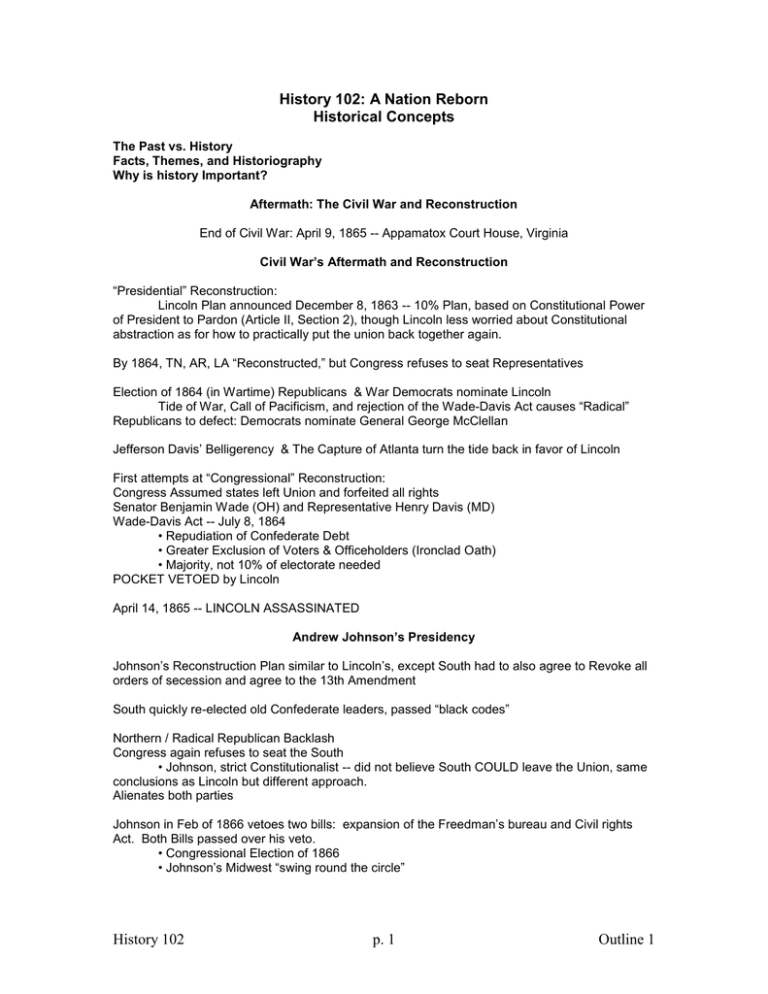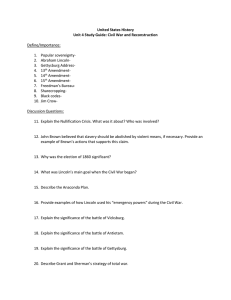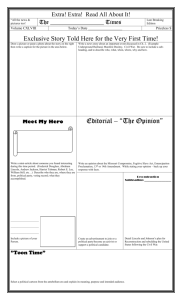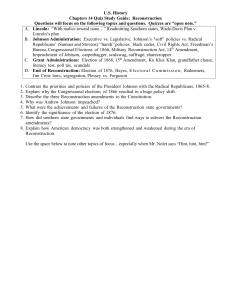A Nation Reborn: Reconstuction and Industrialism
advertisement

History 102: A Nation Reborn Historical Concepts The Past vs. History Facts, Themes, and Historiography Why is history Important? Aftermath: The Civil War and Reconstruction End of Civil War: April 9, 1865 -- Appamatox Court House, Virginia Civil War’s Aftermath and Reconstruction “Presidential” Reconstruction: Lincoln Plan announced December 8, 1863 -- 10% Plan, based on Constitutional Power of President to Pardon (Article II, Section 2), though Lincoln less worried about Constitutional abstraction as for how to practically put the union back together again. By 1864, TN, AR, LA “Reconstructed,” but Congress refuses to seat Representatives Election of 1864 (in Wartime) Republicans & War Democrats nominate Lincoln Tide of War, Call of Pacificism, and rejection of the Wade-Davis Act causes “Radical” Republicans to defect: Democrats nominate General George McClellan Jefferson Davis’ Belligerency & The Capture of Atlanta turn the tide back in favor of Lincoln First attempts at “Congressional” Reconstruction: Congress Assumed states left Union and forfeited all rights Senator Benjamin Wade (OH) and Representative Henry Davis (MD) Wade-Davis Act -- July 8, 1864 • Repudiation of Confederate Debt • Greater Exclusion of Voters & Officeholders (Ironclad Oath) • Majority, not 10% of electorate needed POCKET VETOED by Lincoln April 14, 1865 -- LINCOLN ASSASSINATED Andrew Johnson’s Presidency Johnson’s Reconstruction Plan similar to Lincoln’s, except South had to also agree to Revoke all orders of secession and agree to the 13th Amendment South quickly re-elected old Confederate leaders, passed “black codes” Northern / Radical Republican Backlash Congress again refuses to seat the South • Johnson, strict Constitutionalist -- did not believe South COULD leave the Union, same conclusions as Lincoln but different approach. Alienates both parties Johnson in Feb of 1866 vetoes two bills: expansion of the Freedman’s bureau and Civil rights Act. Both Bills passed over his veto. • Congressional Election of 1866 • Johnson’s Midwest “swing round the circle” History 102 p. 1 Outline 1 Attempted Impeachment of Johnson: Based on Tenure of Office Act and dismissal of Secretary of War Edwin Stanton (Radical Republican sympathizer) 11 CHARGES DRAWN FOR “HIGH CRIMES AND MISDEMEANORS” -- acquitted by 1 Senatorial vote, including 7 crossover Republicans Radical Reconstruction: Scalywags, Carpetbaggers, the Myth of Black Rule 1868 -- Election of US Grant (serves two terms, through 1876) Corruption under Reconstruction governments? -- Part of general corruption of era, leading into the Guilded Age, Thomas Nast REFORMER governments: 1869-1875, white Southerners begin to take back control AFTERMATH OF RECONSTRUCTION: 1. 14th and 15th Amendments 2. Destruction of Planter Aristocracy and rise of Northern business leaders as new aristocrats 3. The benighted, destroyed, devastated South 4. Sharecropping, crop lien system 5. Beginnings of the “new South Myth” (Henry Grady) myths of the Lost Cause and “Moonlight and Magnolia” 6. Founding of KKK in 1866 7. Leads to Plessy versus Fergusun in 1896, creation and justification of Jim Crow segregation of the South (TN, 1870) Industrialism, Capitalism, Technology and The “Guilded Age” Early “Industrialism”; Britain’s lead. Rise of American Technologies 1790 - Samuel Slater opens the first factory, a cotton-spinning mill United States Patent Office Opens (John Stevens) 1793 - Eli Whitney’s Cotton Gin perfected 1800 - Eli Whitney perfects the “Rifle with Interchangeable parts -- beginning in United States of Assembly-line manufactures 1807 - Robert Fulton & Robert R. Livingston improve the steamboat, sail the Claremont up the Hudson River 1817 - The first steamboat to travel UP the Mississippi River from New Orleans to Cincinnati 1851 – William Kelly’s Steel Process 1855 – Bessemer Steel (English) 1860 – 36,000 Patents issued Isaac Singer improves Elias Howe’s Sewing machine 1866 – Cyrus Field, Transatlantic Telegraph 1867 – Christopher Shoales, the Typewriter 1870 – Charles Brush, Arc Lamp 1876 – Alexander Grahm Bell & the Telephone 1879 – James Ritty, the cash register 1880 – Edison: Incandescent lamp, the “talking machine,” (later with George Eastman the motion picture), electric steetcars James Bonsack, Cigarette-making machine 1891 – William Burroughs, calculator Economic Theories, Consolidation and Scandal Economic Theories: History 102 p. 2 Outline 1 Historical: 1776, Adam Smith The Wealth of Nations Change from Mercantilism to law of Supply and Demand Laissez-Faire & The “Invisible Hand” of the Free Market, Competition Herbert Spencer, Social Darwinism Frank Ward, Dynamic Sociology (1883) Horiatio Alger “American Success Story” Andrew Carnegie, The Gospel of Wealth (1901) The rise of stock companies (roots in joint-stock); limited liability New management techniques: Middle Manager Henry Ford, moving Assembly Line The Giants: I.M. Singer and Co. (1851); Western Union (1856); Standard Oil (1870); U.S. Steel (1901); Ford Motor Railroad Tycoons: Cornelius Vanderbuilt, James Hill, Collis Huntington Andrew Carnegie: the Steel industry James Duke: Tobacco J. Pierpoint Morgan: Banker, (U. S. Steel) John Rockefeller: Standard Oil Methods of Control: Horizontal and Vertical expansion “Pools” (Cartels) Trusts (pre-merger; 1889, New Jersey) Monopolies Use of force (Pinkerton Gangs to break strikes) Bribery, Political Manipulation 1890: The Sherman Anti-Trust Act 1895: U. S. v. E. C. Knight and Company (sugar Industry) Rise of Conspicuous Consumption Workers and the Labour Movement Industrial Workforce: First Wave: Rural to Urban movement (U. S. Citizens) Second Wave: Immigrant Labour 25 million immigrants arrived from 1865-1915. Inducements to immigrate : 1. Labor Contract Law (repealed in 1885) 2. Advertisements about the West 3. Pardones (Greek/Italian labor Brokers) First wave of immigration: England, Ireland, Northern Europe Second Wave: Italians, Poles, Russians, Greeks, Slavs, Chinese “Clustering” of occupations: Textiles; French, Poles, Greeks Mining: Italians, Slavs, Poles Railways: Chinese (Especially in California) 1. 2. 3. 4. 5. Conditions / Concerns of Workers: Long Hours (10 –12 hour days, 6 day weeks) Safety Concerns Child Labour (20% of boys, 10% girls age 10-15); the paradox of Women’s Labour Low Wages Job Security History 102 p. 3 Outline 1 Problems of Organizing Fears of the Molly Maguires (western Pennsylvania); “anarchists” and “radicals” 1877 Railroad Strike Cut in Wages (10%) Use of force on both sides President Hayes’ reaction Failures and Bare Successes of Early Labour Movements The Rise and Fall of the Knights of Labor (Uriah Stephens, 1869) Long-term vs Short-term goals; move from secrecy to public life (1870s) “One Union” and “Cooperative System” 700,000 members in 1886; by 1890s Gone The Growth of the American Federation of Labor (AFL) Samuel Gompers Short-term Goals, acceptance of Capitalism, affiliation of craft unions May 1, 1886: The General Strike of 1886 and the Haymarket Square Bombing July 1892: The Homestead Strike (Amalgamated Federation of Iron and Steel Workers) Carnegie, Henry Clay Frick, Governor of Pennsylvania 1894: Pullman Strike George Pullman, model town of Pullman, IL Eugene Debs, American Railway Union Gov. Peter Altgeld vs. President Grover Cleveland: 2,000 troops Two Sources of US Growth: the West and the Rise of Cities Secretary of State William Seward (under Johnson) 1. Buys Alaska from Russia for $7.2 million (“Seward’s Folly”) 2. Midway Islands west of Hawaii annexed 1867 States of the 1860s: Nevada, Nebraska, Kansas 1876: Colorado 1889: North Dakota, South Dakota, Montana, Washington 1890: Wyoming, Idaho 1986: Utah* Homestead Act of 1862 1. 160 Acres; 5 year guarantee 2. 1873: Revision to 1,280 acres Three Stages of Settlement of the West 1. Mining and Nationalism Boom (from 1849, then 1860-1890) Pike’s Peak, 1858 Nevada Comstock Lode (1860-80) $306 million Dakota’s Black Hill 1874 Copper mines (anaconda mine in Colorado) Life in Mining Towns 2. The Cattle Ranching Industry Originally Mexican (first cowboys) Texas: The Mustang and Bronco The Cattle Drive starting in 1866, 260,000 Texas to Missouri Abilene, Kansas: the Chisholm Trail History 102 p. 4 Outline 1 Range Wars and women’s opportunities 3. Farming and Homesteading: The romance of the West Transcontinental Railroad Rainfall of the 1870s 1870: Glidden & Ellwood, Barbed Wire Frederick Jackson Turner, “The Frontier Thesis” 1893, AHA Changing to Commercial farming in 1880s-1900s “Agricultural Malaise” and the move to the Populist movement The American Indian Indian Territory: Consolidation of Cherokee, Creek, Winnebago, others Trail of Tears, Seminole War, sac and Fox Wars of Illinois 1830s New Focus: Plains Indians Sioux, Blackfoot, Cheyenne, Kiowa, Apache, Commanche, Crow Killing of the Buffalo: 1865 15 million; 1875, less than 1,000. “One Big Reservation” to “Concentration” 1851: Separate Reservations, “Treaty Chiefs” Bureau of Indian Affairs Frontier Wars of 1850s-60s Little Crow, Sioux in Minnesota Sand Creek Massacre (black Kettle and Cheyennes) 1864 Fort Lyon, Col. Chivington (First appearance of Col. George Custer against Black Kettle) Montana: Sioux: Crazy Horse, Sitting Bull Little Bighorn 1876 1877: Nez Percé Chief Joseph (Rolling Thunder); Idaho, Washington State, Canada 1870s & 80s: Apaches: Cochise, Geronimo AZ and Mexico Ghost Dance and Wounded Knee (SD) 1890 Dawes Severalty Act 1887: Assimilation Cities and the Immigrant Experience The move from a mostly rural life to urban life: 1860-1920 American Cities vs. European Cities The Immigrant Experience 1. Different places of Immigration 2. New Types of Immigrants 3. Types of Jobs 4. Housing: Tenements 5. Communities: Ethnic Enclaves & the Ghetto Success of some (Jewish, German) Less Success of others (Irish) The "values" thesis (education vs. solidarity, family ties, and order) 6. The question of Assimilation vs. Exclusion and the Generations Anzia Yezierska, The Bread Winners Reform Judiasm 7. The Political "Machine" and the "Boss" William Tweed, New York's Tammany Hall (1860s&70s) Urban Life Dangers History 102 p. 5 Outline 1 Disease Fire: The Great Fires of 1871 (Chicago, Boston) San Francisco Earthquake of 1906 Poverty Crime (Rise of Professional Police Force) Urban Life Changes Rise of Mass Consumption Inventions: Tin Cans (1880); Refrigerated Railway Cars, Artificial Icemaking Rise of Life expectancy Chain Stores: Atlantic and Pacific Tea Company 1870 F. W. Woolworth Sears and Roebuck "Mass Consumption" and women Rise of Leisure Time Sport: Baseball (Abner Doubleday, 1839, West Point, NY) & Football Theaters and Vaudeville: The Ziegfield Follies (Florenz Ziegfield) Jazz, Ragtime, Black entertainers, "Minstrel Singers" D.w. Griffith: The Birth of a Nation(1915), Intolerance (1916) The Rise of American Literature: Southwestern Humourists (Samuel Clemens) Stephen Crane Maggie: Girl of the Steets; The Red badge of Courage Upton Sinclair, The Jungle William Dean Howells, The Rise of Silas Lapham Edgar Allen Poe Lousia May Alcott, Little Women Detective stories, Romance Novels, Westerns, "Tom Swift" "Moral Uplift" (Alger) Mass Communications: William Randolf Hearst New York Journal Joeseph Pulitzer New York World Thomas Nast, Editorial Cartoonist 1889: Edward Bok, Ladies Home Journal Intellectual Life: Darwinism and Evolution (backlash: Protestant Fundamentalism of 20s and 80s) William Grahm Sumner's Social Darwinism William James, Pragmatism Lessons and Themes of Late 19th Century Culture, Politics, Economics: 1. 2. 3. 4. 5. 6. 7. 8. 9. 10. The Rise of Industrial America & Invention Concentration of Power in Business over Government Governmental Corruption Rise of Cities Creation of Society of Consumption Failure of Labour Movements Far Western Expansion, The Frontier Experience, & Indian Removal Growth of Women's Power Disenfranchisement of Blacks Growth of Immigration & Communities Relating Themes to the 20th Century History 102 p. 6 Outline 1 Laying the Foundations for Dissent: Muckrakers, Reformers, Populists, Progressives History 102 p. 7 Outline 1



